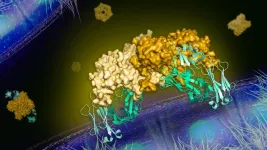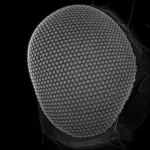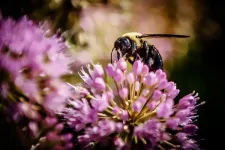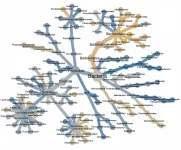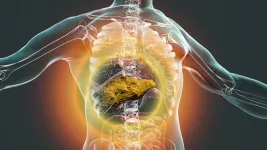(Press-News.org) TORONTO, Jan. 13, 2021 - Close to 5,700 lakes in the Northern Hemisphere may permanently lose ice cover this century, 179 of them in the next decade, at current greenhouse gas emissions, despite a possible polar vortex this year, researchers at York University have found.
Those lakes include large bays in some of the deepest of the Great Lakes, such as Lake Superior and Lake Michigan, which could permanently become ice free by 2055 if nothing is done to curb greenhouse gas emissions or by 2085 with moderate changes.
Many of these lakes that are predicted to stop freezing over are near large human populations and are an important source of drinking water. A loss of ice could affect the quantity and quality of the water.
"We need ice on lakes to curtail and minimize evaporation rates in the winter," says lead researcher Sapna Sharma, an associate professor in the Faculty of Science. "Without ice cover, evaporation rates would increase, and water levels could decline. We would lose freshwater, which we need for drinking and everyday activities. Ice cover is extremely important both ecologically and socio-economically."
The researchers, including Postdoctoral Fellows Kevin Blagrave and Alessandro Filazzola, looked at 51,000 lakes in the Northern Hemisphere to forecast whether those lakes would become ice-free using annual winter temperature projections from 2020 to 2098 with 12 climate change scenarios.
Watch video: https://youtu.be/Y7JSfTJzBFQ
"With increased greenhouse gas emissions, we expect greater increases in winter air temperatures, which are expected to increase much more than summer temperatures in the Northern Hemisphere," says Filazzola. "It's this warming of a couple of degrees, as result of carbon emissions, that will cause the loss of lake ice into the future."
The most at-risk lakes are those in southern and coastal regions of the Northern Hemisphere, some of which are amongst the largest lakes in the world.
"It is quite dramatic for some of these lakes, that froze often, but within a few decades they stop freezing indefinitely," says Filazzola. "It's pretty shocking to imagine a lake that would normally freeze no longer doing so."
The researchers found that when the air temperature was above -0.9 C, most lakes no longer froze. For shallow lakes, the air temperature could be zero or a bit above. Larger and deeper lakes need colder temperatures to freeze - some as cold as -4.8 C ? than shallow lakes.
"Ice cover is also important for maintaining the quality of our freshwater," says Sharma. "In years where there isn't ice cover or when the ice melts earlier, there have been observations that water temperatures are warmer in the summer, there are increased rates of primary production, plant growth, as well as an increased presence of algal blooms, some of which may be toxic."
To preserve lake ice cover, more aggressive measures to mitigate greenhouse gas emissions are needed now, says Sharma. "I was surprised at how quickly we may see this transition to permanent loss of ice cover in lakes that had previously frozen near consistently for centuries."
INFORMATION:
The paper, Forecasting the permanent loss of lake ice in the Northern Hemisphere within the 21st century, was published in Geophysical Research Letters.
York University is a modern, multi-campus, urban university located in Toronto, Ontario. Backed by a diverse group of students, faculty, staff, alumni and partners, we bring a uniquely global perspective to help solve societal challenges, drive positive change and prepare our students for success. York's fully bilingual Glendon Campus is home to Southern Ontario's Centre of Excellence for French Language and Bilingual Postsecondary Education. York's campuses in Costa Rica and India offer students exceptional transnational learning opportunities and innovative programs. Together, we can make things right for our communities, our planet, and our future.
SILVER SPRING, Md.--A new study confirms that treatment with Bimagrumab, an antibody that blocks activin type II receptors and stimulates skeletal muscle growth, is safe and effective for treating excess adiposity and metabolic disturbances of adult patients with obesity and type 2 diabetes.
"These exciting results suggest that there may be a novel mechanism for achieving weight loss with a profound loss of body fat and an increase in lean mass, along with other metabolic benefits," said Steve Heymsfield, MD, FTOS, past president of The Obesity Society and corresponding author of the study. Heymsfield is professor and director of the Metabolism and Body Composition Laboratory at the Pennington Biomedical Research Center in Baton Rouge, La.
A ...
LAWRENCE -- Parents around the world have long told us that breakfast is the most important meal of the day. Soon, basketball coaches may join them.
Researchers at the University of Kansas have published a study showing that eating breakfast can improve a basketball player's shooting performance, sometimes by significant margins. The study, along with one showing that lower body strength and power can predict professional basketball potential, is part of a larger body of work to better understand the science of what makes an elite athlete.
Breakfast and better basketball shooting
Dimitrije Cabarkapa left his native Novi Sad, Serbia, to play basketball at James Madison University. Never a fan of 6 a.m. workouts, he was discussing ...
A team of researchers led by the University of California, Berkeley and the University of Michigan has discovered an antibody that blocks the spread within the body of the dengue virus, a mosquito-borne pathogen that infects between 50 and 100 million people a year. The virus causes what is known as dengue fever, symptoms of which include fever, vomiting and muscle aches, and can lead to more serious illnesses, and even death.
"Protein structures determined at the APS have played a critical role in the development of drugs and vaccines for several diseases, and these new results are key to the development of a potentially effective treatment against flaviviruses." -- Bob Fischetti, group leader with Argonne's X-ray Sciences Division and life sciences ...
The fascinating compound eyes of insects consist of hundreds of individual eyes known as "facets". In the course of evolution, an enormous variety of eye sizes and shapes has emerged, often representing adaptations to different environmental conditions. Scientists, led by an Emmy Noether research group at the University of Göttingen, together with scientists from the Andalusian Centre for Developmental Biology (CABD) in Seville, have now shown that these differences can be caused by very different changes in the genome of fruit flies. The study was published ...
HOUSTON - (Jan. 13, 2021) - Pyrolyzed plastic ash is worthless, but perhaps not for long.
Rice University scientists have turned their attention to Joule heating of the material, a byproduct of plastic recycling processes. A strong jolt of energy flashes it into graphene.
The technique by the lab of Rice chemist James Tour produces turbostratic graphene flakes that can be directly added to other substances like films of polyvinyl alcohol (PVA) that better resist water in packaging and cement paste and concrete, dramatically increasing their compressive strength. ...
CHAMPAIGN, Ill. -- A dramatic decline in bees and other pollinating insects presents a threat to the global food supply, yet it's getting little attention in mainstream news.
That's the conclusion of a study from researchers at the University of Illinois Urbana-Champaign, published this week in a special issue of the Proceedings of the National Academy of Sciences. The study was based on a search of nearly 25 million news items from six prominent U.S. and global news sources, among them The New York Times, The Washington Post and The Associated Press.
The study found "vanishingly low levels of attention to pollinator population topics" over several decades, even compared with ...
Wetlands are the dominant natural source of atmospheric methane, a potent greenhouse gas which is second only to carbon dioxide in its importance to climate change. Anthropogenic climate change is expected to enhance methane emissions from wetlands, resulting in further warming. However, wetland methane feedbacks were not fully assessed in the Intergovernmental Panel on Climate Change (IPCC) Fifth Assessment Report, posing a challenge to meeting the global greenhouse gas mitigation goals set under the Paris Agreement.
To understand how wetland methane cycling may evolve and drive climate feedbacks in the future, scientists are increasingly looking to Earth's past.
"Ice core records indicate ...
People worldwide want their coffee to be both satisfying and reasonably priced. To meet these standards, roasters typically use a blend of two types of beans, arabica and robusta. But, some use more of the cheaper robusta than they acknowledge, as the bean composition is difficult to determine after roasting. Now, researchers reporting in ACS' Journal of Agricultural and Food Chemistry have developed a new way to assess exactly what's in that cup of joe.
Coffee blends can have good quality and flavor. However, arabica beans are more desirable than other types, resulting in a higher market value for blends containing a higher proportion of this variety. In some cases, producers dilute their blends with the less expensive robusta beans, yet that is hard for consumers ...
DURHAM, N.C. -- Biomedical engineers at Duke University have devised an algorithm to remove contaminated microbial genetic information from The Cancer Genome Atlas (TCGA). With a clearer picture of the microbiota living in various organs in both healthy and cancerous states, researchers will now be able to find new biomarkers of disease and better understand how numerous cancers affect the human body.
In the first study using the newly decontaminated dataset, the researchers have already discovered that normal and cancerous organ tissues have a slightly different microbiota composition, that bacteria from these diseased sites can enter the bloodstream, and that this bacterial information could help diagnose ...
Liver transplant priority in the U.S. goes to the sickest patients, which fails to consider other important factors, including how long patients are likely to survive post-transplant.
Researchers with Sylvester Comprehensive Cancer Center at the University of Miami Miller School of Medicine are collaborating with faculty at the University of Pennsylvania to develop a risk score that more comprehensively prioritizes liver cancer patients for transplantation.
Their paper documenting the development and validation of the LiTES-HCC score to predict post-transplant survival for hepatocellular carcinoma, or liver cancer, patients was published in the highly respected peer-reviewed Journal of Hepatology.
The ...

